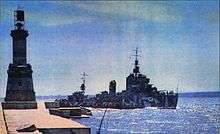Battle of Jibrieni
The Battle of Jibrieni was an attack on 17 December 1941 by a Soviet submarine on an Axis convoy and its Romanian escorts off the coast of the Romanian village of Jibrieni (today Prymorske, Ukraine). The engagement ended with the sinking of the attacking Soviet submarine M-59.
| Battle of Jibrieni | |||||||
|---|---|---|---|---|---|---|---|
| Part of the Black Sea Campaigns of the Eastern Front of World War II | |||||||
 Romanian destroyer Regele Ferdinand | |||||||
| |||||||
| Belligerents | |||||||
|
Cargo ships: |
| ||||||
| Strength | |||||||
|
Escort force: 2 destroyers 2 torpedo boats 2 gunboats Convoy: 3 cargo ships | 1 submarine | ||||||
| Casualties and losses | |||||||
| None |
1 submarine sunk 16–19 killed | ||||||
Battle
On 17 December 1941, the Soviet M-class submarine M-59 carried out an attack against an Axis convoy near the coastal town of Jibrieni in December 1941. The convoy consisted of the Hungarian cargo ships Kassa and Kolozsvár[1] and the Bulgarian cargo ship Tzar Ferdinand.[2] The three ships were escorted by the Romanian destroyers Regele Ferdinand and Regina Maria, the Romanian gunboats Stihi and Ghiculescu and the Romanian torpedo boats Sborul and Smeul. The two torpedoes launched by the Soviet submarine missed the aft and bow of the Romanian destroyer by about 30 feet each. With 25 knots, Regele Ferdinand rushed to the place the torpedoes were launched from and dropped three series of depth charges. Between the second and third series, fuel and bubbles emerged from the water. Regele Ferdinand subsequently circled the area and dropped four more depth charges, followed by more fuel emerging from the depths as well as pieces of wood. Regele Ferdinand reported the sinking of the submarine, which was confirmed by the Romanian Naval Command. Post-war sources revealed the identity of the submarine as M-59.[3][4][5]
Disputed account
According to modern Russian sources, M-59 was probably lost several weeks prior in minefields east of Constanța, in late October or early November before the battle took place. Soviet archival documents state that the submarine did not have enough fuel to operate beyond 8 December on its final patrol, thus making impossible for the submarine to be involved in the engagement on 17 December.[6][7][8] The likely reason of M-59's loss was defensive field of mines east of Constanța,[9] the field responsible being the one laid by the Romanian minelayers Admiral Murgescu, Dacia and Regele Carol I.[10]
See also
References
- Antony Preston, Warship 2001–2002, pp. 77
- Antony Preston, Warship 2001–2002, pp. 80
- Nicolae Koslinski, Raymond Stănescu, Marina română in al doilea război mondial: 1941–1942, Făt-Frumos, 1996, pp. 274–275
- Jipa Rotaru, Ioan Damaschin, Glorie și dramă: Marina Regală Română, 1940–1945, p. 67 (in Romanian)
- Paul E. Fontenoy, Submarines: an illustrated history of their impact, ABC-CLIO, 31 March 2017, p. 275
- M-59 on uboat.net
- M-59 on sovboat.ru
- Antony Preston, Warship, Conway Maritime Press, 2001 p. 75
- Jurgen Rohwer, Stalin's Ocean-going Fleet: Soviet Naval Strategy and Shipbuilding Programs, 1935–53, 2012, p. 265